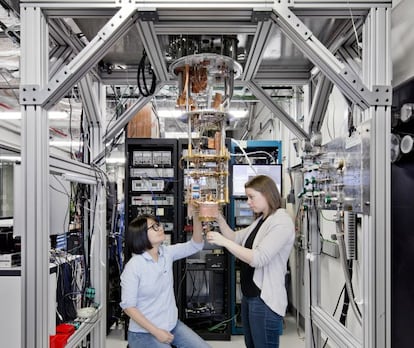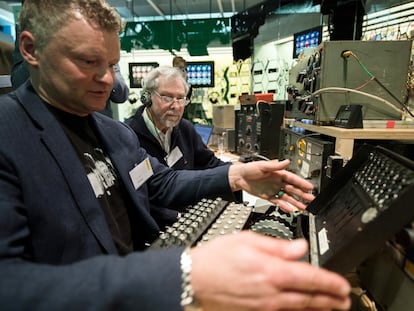‘Classic’ defeats quantum: with the use of conventional computing, two teams surpass IBM’s groundbreaking 127 qubit processor
Simulations utilizing ‘modest computational systems’ have achieved equivalent results as the technology multinational, just weeks after the milestone was published in the journal ‘Nature’

There are records that remain unbeaten for decades… and others that last only for seconds. This was the case for heptathlon athlete Adrianna Sulek, who only got to enjoy her world record for 6.43 seconds. And, in the informal competition between classical and quantum computing, a similar short-lived triumph has also occurred.
On June 14, an investigation published in the journal Nature claimed to have achieved — with 127 qubits — a capacity already present in commercial quantum computers: results that are supposedly impossible in classical computing. Just two weeks later, papers from Caltech and New York University claimed to have achieved more precise resolutions — and this time, they were done with classical computing. “This struggle between the classical and the quantum is very enriching,” says David Pérez García, a researcher at Spain’s Institute of Mathematical Sciences (Icmat) and a professor at the Complutense University of Madrid.
Youngseok Kim, Andrew Eddins and Abhinav Kadala, all IBM researchers, along with other authors, reported in Nature that they have shown how a quantum processor and post-analysis processing can reliably generate, manipulate, and measure quantum states so complex that their properties couldn’t be estimated accurately by conventional approximations.
“No classical computer has enough memory to encode the possibilities calculated by the 127 qubits,” the authors claimed. Göran Wendin and Jonas Bylander, researchers at Chalmers University of Technology, Sweden, backed them up: “The fundamental quantum advantage here is scale rather than speed: the 127 qubits encode a problem for which no classical computer has enough memory.”
However, it appears as if the announcement of this record was only an incentive to try to beat it. Researchers at the Flatiron Institute’s Center for Computational Quantum Physics rose to the challenge. In just 12 days, they published research regarding an “accurate, memory- and time-efficient classical simulation” of the system reported in Nature. “By adopting a tensor network approach, we can perform a classical simulation that is significantly more accurate than the results obtained by the quantum device,” the Flatiron researchers affirm. They stress that the simulation was done with “modest computational resources.”
And, just two days later, researchers from the California Institute of Technology revealed another project in which “a classical algorithm based on Pauli sparse dynamics can efficiently simulate the quantum circuits studied in the recent experiment with the 127 qubits of the processor IBM Eagle.” They also referred to the paper published by the researchers from the Flatiron Institute: “The fact that both classical approaches are successful illustrates the rich landscape of approximate classical algorithms that have yet to be explored. We believe that the method we describe here holds promise not only for quantum circuit simulations, but also for more general simulation problems in quantum dynamics.”
Professor and researcher David Pérez García, an expert in tensor networks (the strategy developed in the first of the alternative works to that of quantum advantage), considers the three investigations to be “surprising.”
“They’re spectacular. That different techniques reproduce the results of the experiment is of even more value. The results are good. They’re not just noise.”
The alternative works to the one published in Nature contradict the conclusion that it’s impossible to achieve the same results with other forms of computation. “[The simulations] show that the [IBM] experiment isn’t at the point of affirming that it cannot be simulated with any classical method,” Pérez García notes. “But I don’t think that the quantum advantage was the main goal… [rather, it was] that you can get good results in large, complex systems, without having to correct errors, which is the dream of quantum computing. There’s [a middle ground] that’s the mitigation of errors, which [can also] provide very interesting results.”
The techniques used were developed to simulate the behavior of quantum systems, but with classical computers. “The simulation itself [is very interesting] and can be used for other types of problems. The field is very dynamic. The difficulties are there and, although the bells and whistles still cannot announce that this technology is already a reality, very promising advances are being observed,” Pérez García concludes.
Sign up for our weekly newsletter to get more English-language news coverage from EL PAÍS USA Edition
Tu suscripción se está usando en otro dispositivo
¿Quieres añadir otro usuario a tu suscripción?
Si continúas leyendo en este dispositivo, no se podrá leer en el otro.
FlechaTu suscripción se está usando en otro dispositivo y solo puedes acceder a EL PAÍS desde un dispositivo a la vez.
Si quieres compartir tu cuenta, cambia tu suscripción a la modalidad Premium, así podrás añadir otro usuario. Cada uno accederá con su propia cuenta de email, lo que os permitirá personalizar vuestra experiencia en EL PAÍS.
¿Tienes una suscripción de empresa? Accede aquí para contratar más cuentas.
En el caso de no saber quién está usando tu cuenta, te recomendamos cambiar tu contraseña aquí.
Si decides continuar compartiendo tu cuenta, este mensaje se mostrará en tu dispositivo y en el de la otra persona que está usando tu cuenta de forma indefinida, afectando a tu experiencia de lectura. Puedes consultar aquí los términos y condiciones de la suscripción digital.
More information

Encryption, 80 years after the Enigma machine
Archived In
Últimas noticias
Venezuela is foreshadowing the new world order that Trump wants to impose
Delcy Rodríguez calls for cooperation with US while Trump demands ‘total access’ in Venezuela
The ‘pure men’ who made Europe tremble
Gilles Lipovetsky: ‘If you want to live better and fall in love, take Prozac, don’t look to philosophy’
Most viewed
- Alain Aspect, Nobel laureate in physics: ‘Einstein was so smart that he would have had to recognize quantum entanglement’
- Gilles Lipovetsky: ‘If you want to live better and fall in love, take Prozac, don’t look to philosophy’
- Maduro’s downfall puts China’s relationship with Venezuela to the test
- Why oil has been at the center of Venezuela-US conflicts for decades
- The US bombing of Venezuela, in pictures










































